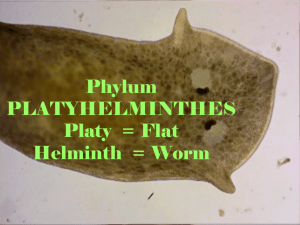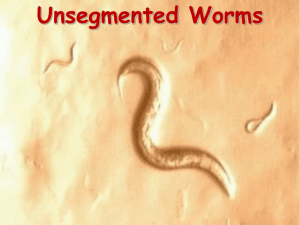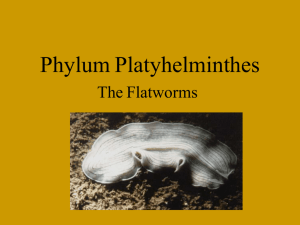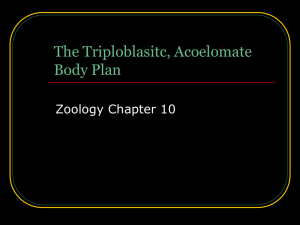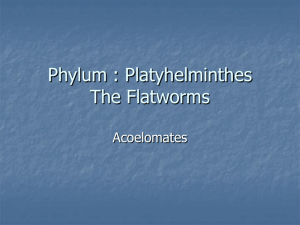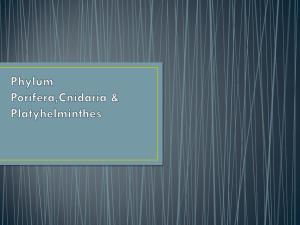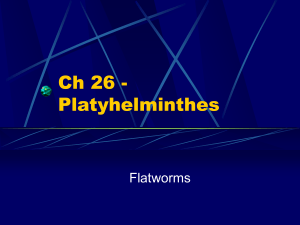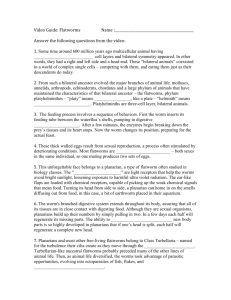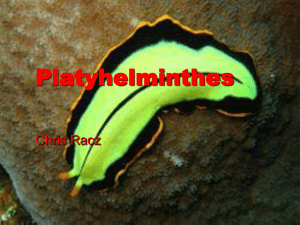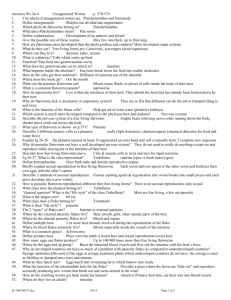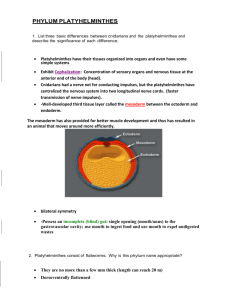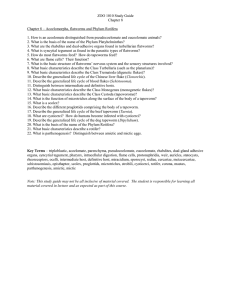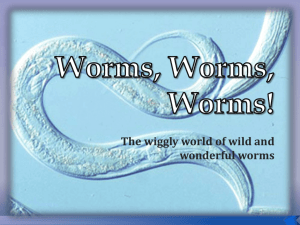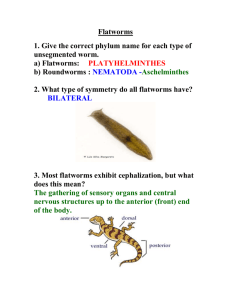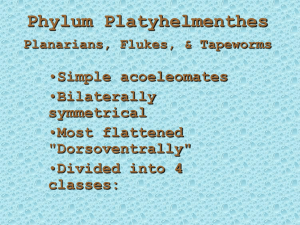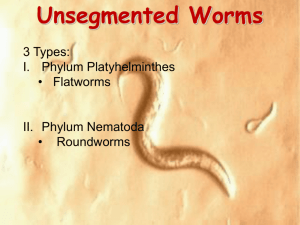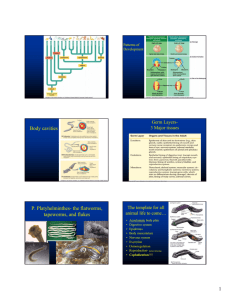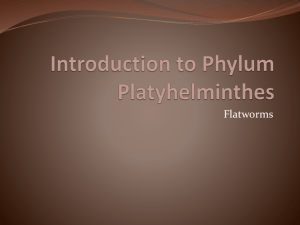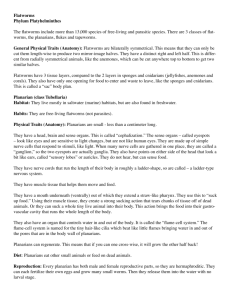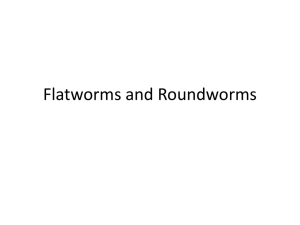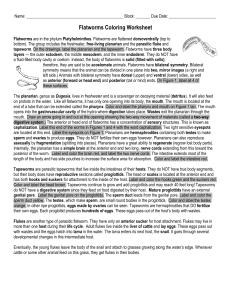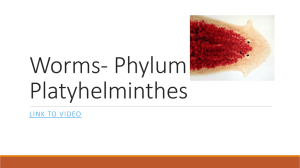Phylum Platyhelminthes - Flatworms Dorsoventrally flattened bodies
advertisement
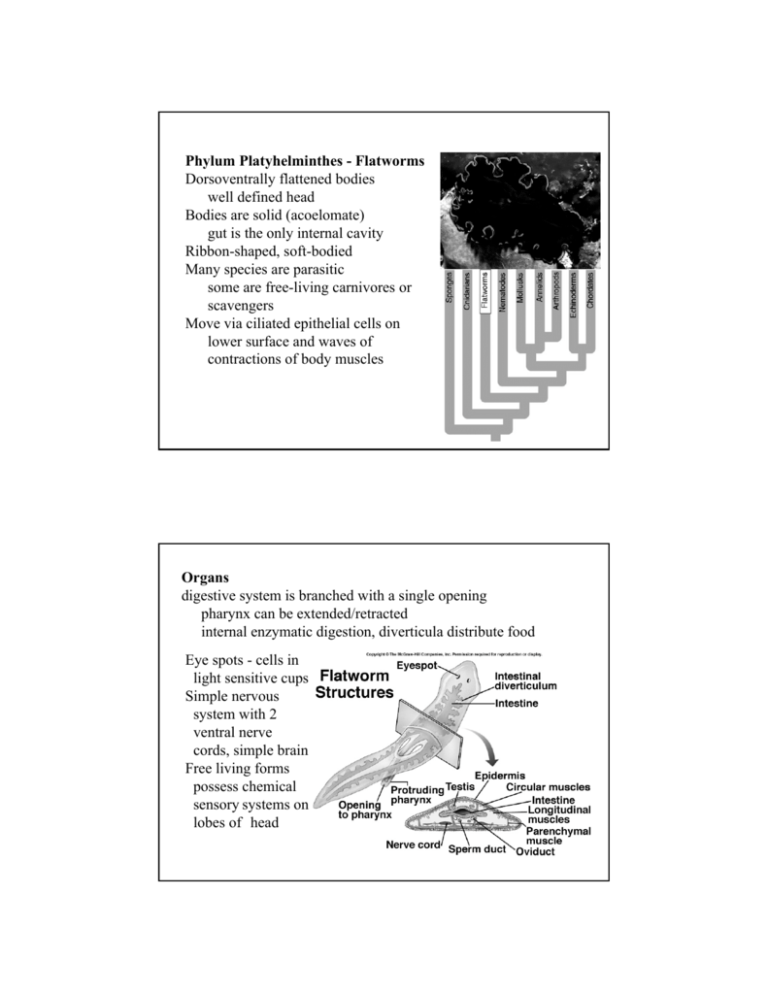
Phylum Platyhelminthes - Flatworms Dorsoventrally flattened bodies well defined head Bodies are solid (acoelomate) gut is the only internal cavity Ribbon-shaped, soft-bodied Many species are parasitic some are free-living carnivores or scavengers Move via ciliated epithelial cells on lower surface and waves of contractions of body muscles Organs digestive system is branched with a single opening pharynx can be extended/retracted internal enzymatic digestion, diverticula distribute food Eye spots - cells in light sensitive cups Simple nervous system with 2 ventral nerve cords, simple brain Free living forms possess chemical sensory systems on lobes of head Reproduction Most are hermaphroditic with internal fertilization and separate ovaries and testes fertilized eggs deposited in cocoons, hatch into miniature adults Can reproduce asexually by fragmentation and regeneration No circulatory system, food and oxygen diffuse to tissues Excretory system is simple “flame cells” propel fluids through tubules to outside of body - primarily for ridding body of excess water Three classes of flatworms Class Turbellaria - free-living flatworms Class Trematoda - flukes Class Cestoda - tapeworms Class Turbellaria - Turbellarians, free-living flatworms predators on smaller organisms, and scavengers found in water and moist habitats Dugesia, the common planarian Class Trematoda - Flukes Parasites on other animals Name originates from their shape Lack sensory and locomotive adaptations of free-living forms feed on host tissue, food taken in through mouth, resistant to host defenses Complex life cycles Example: Clonorchis, human liver fluke - Adults live in association with liver - Eggs passed in feces - Ingested by snail transform into swimming larva that leaves snail - Nonciliated redia give rise to cercariae - Bore into fish, encyst in muscle Humans eat uncooked fish, flukes migrate to liver Example: Schistosoma blood flukes Causes disease: schistosomiasis “bilharzia” is spreading through the tropics Class Cestoda - Tapeworms Highly specialized parasites Adults live in the gut of vertebrates attached to intestinal wall Body divided into scolex, neck and reproductive proglottids (strobila) Absorb food through outer body wall Proglottids formed continuously from region behind scolex at neck Hermaphroditic with testes and ovaries in each proglottid Eggs toward end mature, become fertilized - may be self-fertilized Embryos and proglottids leave host in feces Example: Taenia saginata, beef tapeworm - a parasite of humans Phylum Nematoda - Roundworms Include nematodes, eelworms and roundworms Abundant in marine, freshwater and terrestrial habitats - found everywhere Most are microscopic in size predators, parasites, and scavengers Trichinella - the cause of trichinosis Pseudocoelomate body plan - No mesoderm associated with the gut Bilaterally symmetrical, cylindrical, unsegmented, covered by thick flexible cuticle that is molted periodically longitudinal muscles located beneath the epidermis, pull against cuticle and water filled pseudocoel - Results in side-to-side whipping movement - move well through loose soil or tissues Digestive system with piercing stylets, mouth, pharynx, intestine, and anus Sexual reproduction usually separate sexes and internal fertilization, fertilized eggs laid Many nematodes parasitize humans - Ascaris, hookworms, pinworms Example: Trichinella - pig intestinal roundworm Worm lives in small intestine of pig, young encyst in same host Trichinosis can result if humans eat raw or undercooked pork Worms may also infect bears
